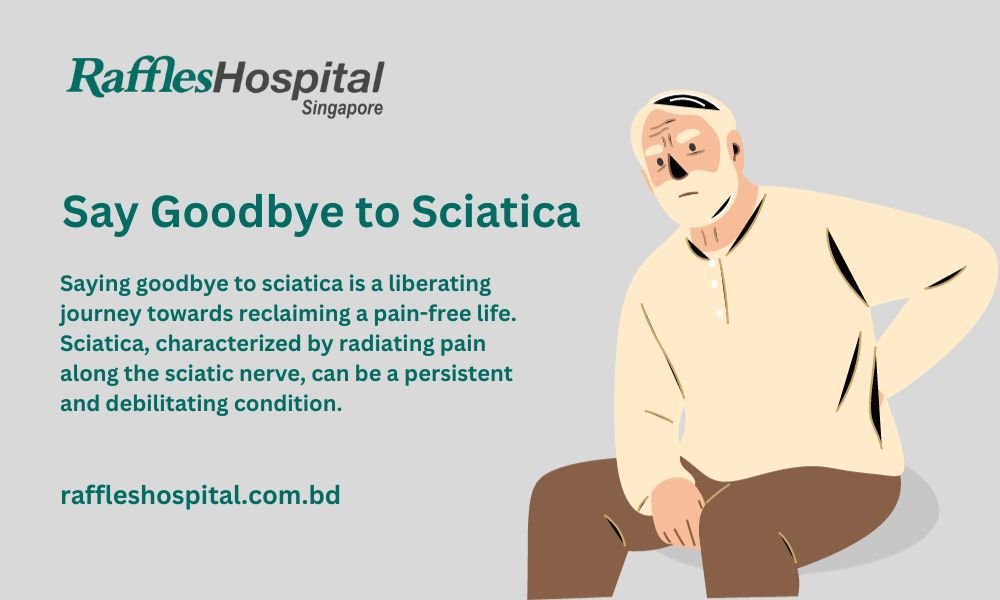Saying goodbye to sciatica is a liberating journey towards reclaiming a pain-free life. Sciatica, characterized by radiating pain along the sciatic nerve, can be a persistent and debilitating condition. However, with the right approach to treatment and lifestyle adjustments, bidding farewell to sciatica is not only achievable but also empowering. Embracing targeted exercises, stretching routines, and ergonomic changes can significantly alleviate the discomfort associated with sciatic nerve pain. Seeking professional guidance and adopting a holistic approach to well-being are essential steps in saying goodbye to sciatica for good. Remember, with dedication and informed choices, the path to a pain-free existence awaits.
Saying goodbye to sciatica after learning about it
Sciatica is a condition that causes pain in the lower back and leg, often radiating down the back of the thigh and into the calf and foot. It’s caused by irritation or compression of the sciatic nerve, the largest nerve in the body.
Symptoms of sciatica:
- Pain in the lower back, buttocks, thigh, leg, and foot
- Leg or foot tingling, numbness, or weakness
- Difficulty moving the leg or foot
- Burning or sharp pain in the leg or foot
Causes of Sciatica
Sciatica, a condition causing pain along the sciatic nerve, can be attributed to a range of factors. Exploring these causes in depth enhances our understanding and aids in formulating targeted treatment plans.
Herniated Discs
One primary cause of sciatica is herniated discs. The intervertebral discs, acting as cushions between vertebrae, can rupture or bulge, exerting pressure on the adjacent nerves, including the sciatic nerve. This compression results in pain, tingling, and numbness along the nerve pathway.

Say Goodbye to Sciatica
Spinal Stenosis
Sciatica may also stem from spinal stenosis, a condition where the spinal canal narrows, exerting pressure on the nerves. In this context, the sciatic nerve can be affected, leading to symptoms characteristic of sciatica. Growing older and degenerative changes to the spine are frequently linked to spinal stenosis.
Injury and Trauma
A physical injury or trauma to the spine and surrounding tissues can initiate sciatica. Accidents, falls, or sports-related injuries may cause inflammation or compression of the sciatic nerve. Understanding the specific nature of the injury is crucial for tailoring an effective treatment approach.
Piriformis Syndrome
The piriformis muscle, located in the buttocks, plays a role in sciatica. When the sciatic nerve passes through or under the piriformis muscle, it can lead to compression or irritation, resulting in sciatic pain. Piriformis syndrome, characterized by spasms or tightness in this muscle, is a lesser-known but significant contributor to sciatica.
Degenerative Disc Disease
The natural aging process can contribute to sciatica through degenerative disc disease. As discs lose their water content and elasticity over time, they become more susceptible to damage. This deterioration can lead to disc herniation and subsequent sciatic nerve compression.
Spondylolisthesis
Spondylolisthesis, a condition where a vertebra slips forward over an adjacent vertebra, can cause sciatica. This displacement may narrow the spinal canal or put pressure on the nerves, including the sciatic nerve. Identifying and addressing spondylolisthesis is crucial in managing sciatic symptoms.
Pregnancy
In some cases, sciatica can occur during pregnancy. The weight of the growing uterus may press on the sciatic nerve, leading to pain and discomfort. Hormonal changes during pregnancy can also contribute to the relaxation of muscles and ligaments, potentially impacting the sciatic nerve.
Understanding these diverse causes of sciatica enables healthcare professionals to tailor treatments that address the specific underlying factors. Whether it’s managing disc-related issues, addressing spinal abnormalities, or mitigating the impact of injuries, a comprehensive approach ensures effective relief for individuals dealing with sciatic pain.
Diagnosing Sciatica
Accurate diagnosis is key to effective management. Medical professionals employ diagnostic tests such as MRI scans and nerve conduction studies to pinpoint the underlying issues.
Traditional Treatments
Traditional treatments often include pain relievers and anti-inflammatory medications. These provide temporary relief but may not address the root cause.
Holistic Approaches
A person’s total well-being is taken into account in holistic methods. A complete treatment can be achieved by combining therapies, including herbal medicines, chiropractic adjustments, and acupuncture. Saying goodbye to sciatica can be achieved in this way.
Lifestyle Changes for Relief
Simple lifestyle modifications, such as maintaining good posture, can significantly reduce sciatica symptoms. Small adjustments in daily activities can make a substantial difference.
Say Goodbye to Sciatica: Effective Ways to Get Rid of the Pain
Setting off on the path to say goodbye to sciatica requires a diversified strategy. Here are effective ways to alleviate the pain and improve your quality of life:
Physical Therapy for Sciatica
Engaging in targeted physical therapy exercises helps strengthen muscles, improve flexibility, and alleviate sciatic pain. A skilled therapist tailors exercises to individual needs, offering a personalized approach to recovery.
Exercise Routines for Relief
Incorporating regular exercise into your routine can play a pivotal role in managing sciatica. Prioritize exercises that improve flexibility and core strength since they improve overall spinal health. Say goodbye to sciatica now.
Ergonomic Solutions for Daily Life
Simple changes in your workspace or daily habits can make a significant impact. Investing in ergonomic furniture and maintaining proper body mechanics contribute to reducing sciatica discomfort.
Nutrition and Sciatica
A well-balanced diet rich in anti-inflammatory foods can aid in managing sciatica. Omega-3 fatty acids, found in fish and flaxseeds, have anti-inflammatory properties that may alleviate pain.

Say Goodbye to Sciatica
Mind-Body Techniques for Pain Management
Practices like yoga and meditation not only promote relaxation but also contribute to pain management. These mind-body techniques empower individuals to cope with sciatica more effectively.
Alternative Therapies for Sciatica
Exploring alternative therapies such as acupuncture and massage can offer relief. These modalities focus on holistic healing, addressing both the physical and mental aspects of pain.
Coping Strategies for Chronic Pain
Living with chronic pain requires adopting coping strategies. Support groups, counseling, and mindfulness practices empower individuals to navigate the challenges of sciatica.
Conclusion
In the journey to say goodbye to sciatica, a holistic approach encompassing physical therapy, exercise, lifestyle modifications, and alternative therapies proves effective. Understanding the condition, its causes, and adopting a proactive stance empowers individuals to manage sciatica and embrace a life free from persistent pain.
FAQs Of Goodbye to Sciatica
Q: Can sciatica be cured completely?
Sciatica is often manageable, and symptoms can be alleviated with various treatments. However, complete cure depends on the underlying cause, and some cases may require ongoing management.
Q: Is surgery the only option for severe sciatica?
Surgery is considered when conservative treatments fail. However, it’s not the only option. Many find relief through non-invasive methods, so surgery is typically a last resort.
Q: How long does it take to feel improvement with physical therapy?
The duration varies, but many individuals experience improvement within a few weeks of consistent physical therapy. Results depend on the severity of the condition and individual response.
Q: Are there specific exercises to avoid with sciatica?
Certain exercises, like heavy lifting or intense forward bending, may aggravate sciatic pain. Tailor your exercise routine with the guidance of a healthcare professional.
Q: Can sciatica affect both legs?
While it typically affects one leg, sciatica can impact both legs in some cases. See a medical professional for a precise diagnosis and the best course of action.
Q: How important is posture in managing sciatica?
Maintaining good posture is crucial. Poor posture can exacerbate sciatica symptoms, so adopting ergonomic practices in daily life is beneficial.

